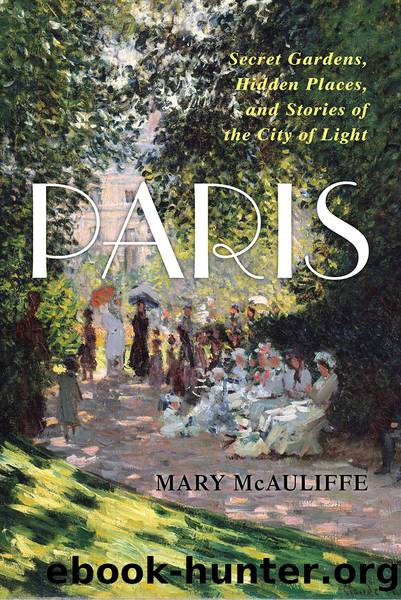Paris by Mary McAuliffe

Author:Mary McAuliffe
Language: eng
Format: epub
Publisher: Rowman & Littlefield Publishers
Published: 2023-01-25T00:00:00+00:00
If you are paying attention to your map, youâll note the Bièvreâs imprint everywhereâon the placement and curvature of streets as well as on place-names summoning up images of trees, flowers, and country mills. From Place de Rungis, the lower streambed curves around what now is the Cité Florale via Rue Brillat-Savarin to Rue Wurtz. Along the way you will find other jewels, such as Petite Alsace (10 Rue Daviel), a picturesque enclave of half-timbered houses, and Rue Le Dantec, a lovely old street at the base of the quiet and village-like Butte-aux-Cailles.
Crossing under Petite Alsace, the upper Bièvre met up with its sister branch at Boulevard Auguste-Blanqui. Here the two passed through a double watergate in the old toll walls (the Farmers-General Wall, demolished in 1860) and once again divided. The higher stream flowed along what now is Rue Edmond-Gondinet, where it passed another watermill (the Moulin Croulebarbe, at the corner of Rue Corvisart), while the lower stream ran along what now is Rue Paul-Gervais. Together, the two arms enclosed a lush enclave that once provided kitchen plots for Gobelins workers and now is the Square René-Le Gall, a secret garden and small wood that encompass the course of the Bièvre. The riverâs waters emerge on the western side of the park, where they burble their way along a pathway beside a school, ending in a small pool within the park.
This place has a history: here, long ago, during a violent thunderstorm, a tormented young man stabbed to death a beautiful shepherdess who had spurned him. If this sounds like something from a Victor Hugo novel, you are not far wrong, for the beautiful Square René-Le Gall spreads over the former Champ de lâAlouette, or Field of the Lark, where the young shepherdess died. Attracted by the storyâs dark drama, Hugo used this spot as the site that so magnetically drew Marius, the yearning young lover of Les Misérables.
While in the vicinity, Victor Hugo frequented the rustic tavern that still stands at 41 Rue de Croulebarbe, along what once was a riverbank path. Nowadays, this tavernâwhich still sports the name âCabaret de Madame Grégoireâ on its façadeâis a Basque restaurant, the Auberge Etchegorry, whose cassoulet is worth sampling. Nowadays, this rustic auberge overlooks Square René-Le Gallâs gently flowing water and densely forested interiorâa haven of peace and greenery on the banks of the riverâs ancient course.
From Rue de Croulebarbe, follow the upper Bièvreâs curve along Rue Berbier-du-Mets, behind the venerable Gobelins textile workshops. Nearby is the Hôtel de la Reine Blanche (at 17 and 19 Rue des Gobelins), twin Gothic mansions where a royal queen (we do not know which) dwelled during her widowhood, when white still was the prescribed color of mourning for widowed queens. Legend has it that the queen in question was Blanche of Castille, mother of Saint Louis, but there are other candidates. And although the original mansion, dating from around the year 1300, was razed after a tragedy took place there (a ball during
Download
This site does not store any files on its server. We only index and link to content provided by other sites. Please contact the content providers to delete copyright contents if any and email us, we'll remove relevant links or contents immediately.
Spell It Out by David Crystal(35349)
Underground: A Human History of the Worlds Beneath Our Feet by Will Hunt(11263)
A Year in the Merde by Stephen Clarke(4659)
Venice by Jan Morris(2052)
Claridge's: The Cookbook by Nail Martyn & Erickson Meredith(1964)
My Paris Kitchen: Recipes and Stories by Lebovitz David(1893)
A TIME OF GIFTS by Patrick Leigh Fermor(1850)
The Plantagenets by Dan Jones(1617)
Welcome to the Goddamn Ice Cube by Blair Braverman(1603)
Bang Poland: How To Make Love With Polish Girls In Poland by Roosh V(1590)
Top 10 Prague (EYEWITNESS TOP 10 TRAVEL GUIDES) by DK(1569)
From Russia with Lunch by David Smiedt(1551)
The Finnish Way by Katja Pantzar(1537)
The Isle of Mull by Terry Marsh(1520)
A TIME TO KEEP SILENCE by Patrick Leigh Fermor(1499)
Rick Steves London 2018 by Rick Steves & Gene Openshaw(1494)
A Taste of Paris by David Downie(1492)
Merde in Europe by Stephen Clarke(1436)
Insight Guides Experience Tokyo by Insight Guides(1419)
